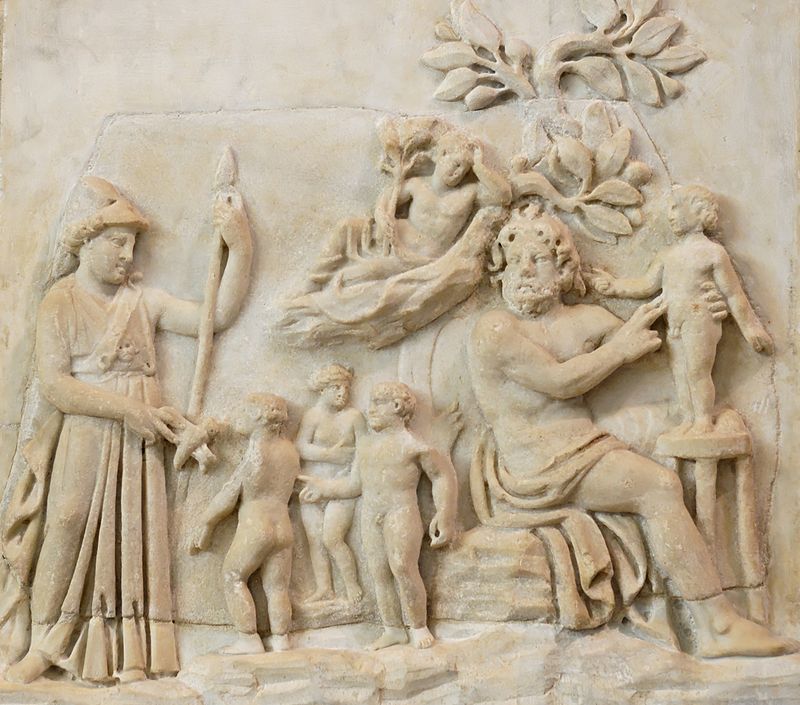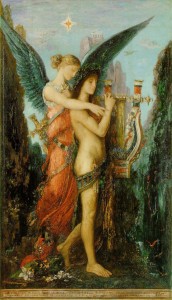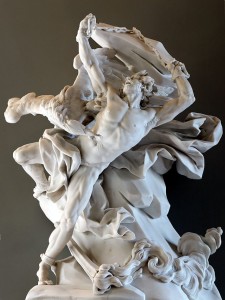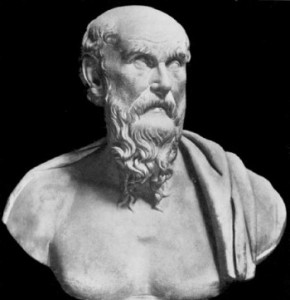
The Theogony (Greek: Θεογονία, Theogonía, pronounced, i.e. “the genealogy or birth of the gods” is a poem by Hesiod (8th – 7th century BC) describing the origins and genealogies of the Greek gods, composed circa 700 B.C. It is written in the Epic dialect of Homeric Greek.

First generation
After the speaker declares that he has received the blessings of the Muses and thanks them for giving him inspiration, he explains that Chaos arose spontaneously. Then came Gaia (Earth), the more orderly and safe foundation that would serve as a home for the gods and mortals, and Tartarus, in the depths of the Earth, and Eros, the fairest among the deathless gods. Eros serves an important role in sexual reproduction, before which children had to be produced asexually.
From Chaos came Erebus (place of darkness between the earth and the underworld) and Nyx (Night). Erebus and Nyx reproduced to make Aether (the outer atmosphere where the gods breathed) and Hemera (Day). From Gaia came Uranus (Sky), the Ourea (Mountains), and Pontus (Sea).
Uranus mated with Gaia to create twelve Titans: Oceanus, Coeus, Crius, Hyperion, Iapetos, Theia, Rhea, Themis, Mnemosyne, Phoebe, Tethys and Cronus; three cyclopes: Brontes, Steropes and Arges; and three Hecatonchires: Kottos, Briareos, and Gyges.

Second generation
Uranus was disgusted with his children, the Hecatonchires, so he hid them away somewhere in Gaia. Angered by this, Gaia asked her children the Titans to punish their father. Only Cronus was willing to do so. Cronus castrated his father with a sickle from Gaia. The blood from Uranus splattered onto the earth producing Erinyes (the Furies), Giants, and Meliai. Cronus threw the severed testicles into the Sea (Thalassa), around which foam developed and transformed into the goddess of Love, Aphrodite (which is why in some myths, Aphrodite was daughter of Uranus and the goddess Thalassa).
Meanwhile, Nyx alone produced children parthenogenetically: Moros (Doom), Oneiroi (Dreams), Ker and the Keres (Destinies), Eris (Discord), Momos (Blame), Philotes (Love), Geras (Old Age), Thanatos (Death), Moirai (Fates), Nemesis (Retribution), Hesperides (Daughters of Night), Hypnos (Sleep), Oizys (Hardship), and Apate (Deceit).
From Eris, following in her mother’s footsteps, came Ponos (Pain), Hysmine (Battles), the Neikea (Quarrels), the Phonoi (Murders), Lethe (Oblivion), Makhai (Fight), Pseudologos (Lies), Amphilogia (Disputes), Limos (Famine), Androktasia (Manslaughters), Ate (Ruin), Dysnomia (Anarchy and Disobedient Lawlessness), the Algea (Illness), Horkos (Oaths), and Logoi (Stories).

After Uranus’s castration, Gaia married Pontus and they have a descendent line consisting of sea deities, sea nymphs, and hybrid monsters. One child of Gaia and Pontus is Nereus (Old Man of the Sea), who marries Doris, a daughter of Oceanus and Tethys, and has Nereids, the fifty nymphs of the sea, one of whom is Thetis. Another child of Gaia and Pontus is Thaumas, who marries Electra, a sister of Doris, and has Iris (Rainbow) and two Harpies.
Phorcys and Ceto, two siblings, marry each other and have the Graiae, the Gorgons, Echidna, and Ophion. Medusa, one of the Gorgons, has two children with Poseidon: the winged horse Pegasus and giant Chrysaor, at the instant of her decapitation by Perseus. Chrysaor marries Callirhoe, another daughter of Oceanus, and has the three-headed Geryon.
Gaia also marries Tartarus and has Typhon, whom Echidna marries and has Orthos, Kerberos, Hydra, and Chimera. From Orthos and either Chimera or Echidna were born the Sphinx and the Nemean Lion.

In the family of the Titans, Oceanus and Tethys marry and have three thousand rivers (including the Nile and Skamandar) and three thousand Okeanid Nymphs (including Electra, Calypso, and Styx). Theia and Hyperion marry and have Helios (Sun), Selene (Moon), and Eos (Dawn). Kreios and Eurybia marry to bear Astraios, Pallas, and Perses. Eos and Astraios will later marry and have Zephyros, Boreas, Notos, Eosphoros, Hesperos, Phosphoros and the Stars (foremost of which are Phaenon, Phaethon, Pyroeis, Stilbon, those of the Zodiac and those three acknowledged before).
From Pallas and Styx (another Okeanid) came Zelus (Zeal), Nike (Victory), Cratos (Strength), and Bia (Force). Koios and Phoibe marry and have Leto, Asteria (who later marries Perses and has Hekate). Iapetos marries Klymene (an Okeanid Nymph) and had Atlas, Menoetius, Prometheus, and Epimetheus.

Third and final generation
Cronus, having taken control of the Cosmos, wanted to ensure that he maintained power. Uranus and Gaia prophesied to him that one of his children would overthrow him, so when he married Rhea, he made sure to swallow each of the children she birthed: Hestia, Demeter, Hera, Hades, Poseidon, Zeus (in that order). However, Rhea asked Gaia and Uranus for help in saving Zeus by sending Rhea to Crete to bear Zeus and giving Cronus a huge stone to swallow thinking that it was another of Rhea’s children. Gaia then took Zeus and hid him deep in a cave beneath the Aegean Mountains.
Tricked by Gaia (the Theogony does not detail how), Cronus regurgitated his other five children. Joining with Zeus, they waged a great war on the Titans for control of the Cosmos. The war lasted ten years, with the Olympian gods, Cyclopes, Prometheus and Epimetheus, the children of Klymene, on one side, and the Titans and the Giants on the other (with only Oceanos as a neutral force). Eventually Zeus released the Hundred-Handed ones to shake the earth, allowing him to gain the upper hand, and cast the fury of his thunderbolts at the Titans, throwing them into Tartarus. Zeus later battled Typhon, a son of Gaia and Tartarus, created because Gaia was angry that the Titans were defeated, and was victorious again.

Because Prometheus helped Zeus, he was not sent to Tartarus like the other Titans. However, Prometheus sought to trick Zeus. Slaughtering a cow, he took the valuable fat and meat, and sewed it inside the cow’s stomach. Prometheus then took the bones and hid them with a thin layer of fat. Prometheus asked Zeus’ opinion on which offering pile he found more desirable, hoping to trick the god into selecting the less desirable portion. However, Hesiod relates that Zeus saw through the trick and responded in a fury. Zeus declared that the ash tree would never hold fire, in effect denying the benefit of fire to man. In response, Prometheus sneaked into the gods’ chambers and stole a glowing ember with a piece of reed. Prometheus then defies the gods and gives fire to humanity (theft of fire).

For this theft, Zeus punished Prometheus by chaining him to a cliff, where an eagle fed on his ever-regenerating liver every day. Prometheus would not be freed until Heracles, a son of Zeus, came to free him. Since man had access to fire, Zeus devised woman as a general punishment, in trade. Hephaistos and Athena built woman with exquisite detail, and she was considered beautiful by all men and gods. (It is generally agreed in academic translations that this woman was Pandora.) Hesiod writes that, despite her beauty, woman is a bane for mankind, attributing women with laziness and a waste of resources. Hesiod notes that Zeus’ curse, womankind, can only bring man suffering, whether by taking a woman as his wife, or by trying to avoid marriage.
Zeus married seven wives. The first was the Oceanid Metis, whom he swallowed to avoid begetting a son who, as had happened with Cronus and Uranus, would overthrow him, as well as to absorb her wisdom so that she could advise him in the future. He would later “give birth” to Athena from his head, which would anger Hera enough for her to produce her own son parthenogenetically, Typhaon, the part snake, part dragon sea monster, or in other versions Hephaistos, god of fire and blacksmiths. The second wife was Themis, who bore the three Horae (Hours): Eunomia (Order), Dikē (Justice), Eirene (Peace); and the three Moirai (Fates): Clotho (Spinner), Lachesis (Alotter), Atropos (Unturned), as well as Tyche (Luck). Zeus then married his third wife Eurynome, who bore the three Charites (Graces): Aglaia, Euphrosyne, and Thalia.

The fourth wife was his sister, Demeter, who bore Persephone. The fifth wife of Zeus was another aunt, Mnemosyne, from whom came the nine Muses: Clio, Euterpe, Thalia, Melpomene, Terpsikhore, Erato, Polymnia, Urania, and Calliope. The sixth wife was Leto, who gave birth to Apollo and Artemis. The seventh and final wife is Hera, who gave birth to Hebe, Ares, Enyo, Hephaistos, and Eileithyia. Of course, though Zeus no longer marries, he still has affairs with many other women, such as Semele, mother of Dionysus, Danae, mother of Perseus, Leda, mother of Castor and Polydeuces and Helen, and Alkmene, the mother of Heracles, who married Hebe.
Poseidon married Amphitrite and produced Triton. Aphrodite, who married Hephaistos, nevertheless had an affair with Ares to have Eros (Love), Phobos (Fear), Deimos (Terror), and Harmonia (Harmony), who would later marry Cadmus to sire Ino (who with her son, Melicertes would become a sea deity), Semele (Mother of Dionysos), Autonoë (Mother of Actaeon), Polydorus, and Agave (Mother of Pentheus). Helios and Perseis birthed Circe. Circe, with Poseidon, in turn, begat Phaunos, god of the forest, and, with Dionysos, mothered Comos, god of revelry and festivity. After coupling with Odysseus, Circe would later give birth to Agrius, Latinus, and Telegonos. Atlas’ daughter Calypso would also bear Odysseus two sons, Nausithoos and Nausinous.
Source http://en.wikipedia.org/wiki/Theogony
Be the first to comment